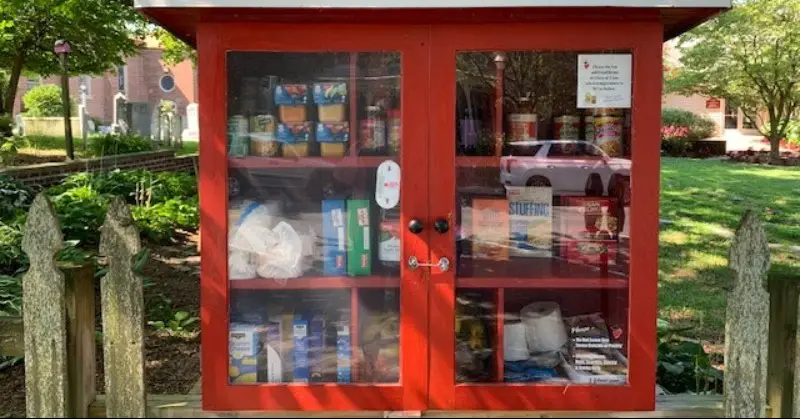
The community food cupboard in this image may seem small, but for one person or family, it could make a huge difference in getting through the day as they wrestle with the food insecurity ramping up quickly in the U.S.
An independent research group at the University of Chicago (NORC) conducted an analysis called the “COVID Impact Survey” and compared results with USDA food security surveys tracking U.S. households since 1998.1
Households were considered food insecure if the respondent indicated the following statements were often or sometimes true:2
- The food we bought just didn’t last and we didn’t have enough money to get more.
- The children in my household were not eating enough because we just couldn’t afford enough food.
At its peak in the wake of the Great Recession, the USDA survey found that 14.9% of households rated as food insecure.3 In April 2020, the COVID Impact Survey found that 34.5% of households with a child 18 and under were food insecure.1
This astounding increase holds no promise of declining soon. Unemployment soared to its highest level since the Great Depression, with 20.5 million jobs lost in April alone, 4 and it will take a very long time before jobs recover.
We have shared several articles on our site that explain a link between climate change and outbreaks of infectious disease. ProPublica published an informative article that makes this ominous statement: “A catastrophic loss in biodiversity, reckless destruction of wildland and warming temperatures have allowed disease to explode. Ignoring the connection between climate change and pandemics would be ‘dangerous delusion,’ one scientist said.”5 As I read such a statement, it is hard to dismiss fears that COVID-19 is just the beginning of modern and far-reaching global pandemics that will disrupt our society in heart-wrenching ways.
When met with staggering statistics and blunt realities, such as those cited above, it is easy to feel powerless. But I try to renew hope by returning to the concept “Think Globally, Act Locally.” That little food cupboard pictured here is doing exactly that.

What’s more, if you peer into the contents of the cupboard more closely, you will see that it’s not filled with easily donated surplus foods. Rather, the items have been carefully chosen by members of an outreach ministry to ensure those served by the “Little Cupboard” have a safe and dependable place to find healthy food (Annie’s Vegan Mac & Cheese, Reduced Sodium Garbanzo Beans, Organic Maple Brown Sugar Cinnamon cereal, Wild-Caught Light Tuna in Water!), drinks, and toiletry items. It is a thoughtful and caring effort, the kind of which is urgently needed by so many of our neighbors—more and more each day.
A sign at the bottom of the little community cupboard says, “Take what you need. Give what you can.” I hope that highlighting their work might inspire readers to discuss ways to do this in your own communities or volunteer to help with similar efforts that may already be in place.
—R.A. Kroft
Sources:
1The COVID-19 Household Impact Survey (https://www.covid-impact.org/), conducted by NORC at the University of Chicago for the Data Foundation. Data release April 30, 2020.
2Bauer, Lauren. The COVID-19 Crisis Has Already Left Too Many Children Hungry in America. Brookings. 6 May 2020.
3Coleman-Jensen, Alisha, Matthew P. Rabbitt, Christian A. Gregory, and Anita Singh. 2019. Household Food Security in the United States in 2018, ERR-270, U.S. Department of Agriculture, Economic Research Service.
4Bayly, Lucy. Unemployment Rate Soars to 14.7%, Highest Level Since the Great Depression. NBC News. 8 May 2020.
5Lustgarten, Abrahm. How Climate Change Is Contributing to Skyrocketing Rates of Infectious Disease. ProPublica. 7 May 2020.
—
R.A. Kroft writes about her day-to-day journey in living a smaller, more sustainable life and other topics that interest her.

This Site Was Inspired By An Interest in Protecting the Environment:
We had the privilege and joy of learning from Dr. Charlie Stine who instilled a love for the natural world through incredible field trips with the Johns Hopkins Odyssey Certificate program in Environmental Studies. At the time, the program was endorsed by the Maryland Department of Natural Resources. Sadly, after Dr. Stine retired, the program was phased out. We hope that we honor his legacy by shining a bright light on environmental issues and sharing good news about the success of various conservation programs when possible.
